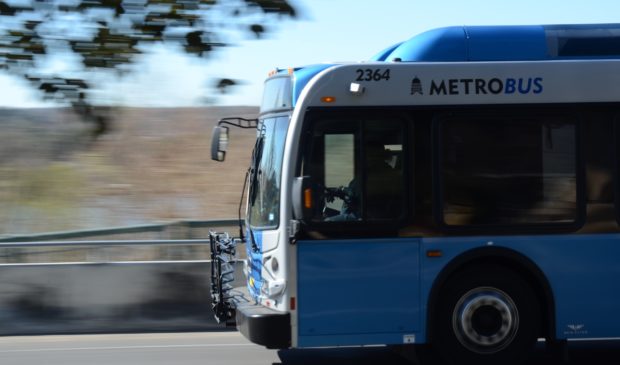Can Austin get dedicated transit lanes without losing car lanes?
Tuesday, March 5, 2019 by
Jack Craver Mayor Steve Adler and Capital Metro Transportation Authority leaders say it is critical that Austin put in place a high-capacity public transit system that runs in a dedicated right-of-way, but that the new system does not have to come at the expense of existing car lanes.
“We’re talking about creating dedicated pathways so that this rapid transit is out of the flow of transit,” Adler said during a joint meeting of City Council and members of the Capital Metro Board of Directors on Monday.
“Certainly in most places this can be accommodated at-grade in the existing right-of-way and certainly with a goal being not to eliminate any existing through travel lanes,” he added. “Some places where we have limited access we’re going to have to look at available options, including acquiring additional right-of-way or going above ground or below ground.”
Dave Couch, who heads Project Connect for Capital Metro, similarly said it’s the goal to preserve existing travel lanes for cars.
Preserving all existing lanes on the targeted corridors is a challenge due to serious physical constraints, particularly for the Orange Line, the route that is proposed to run along North Lamar Boulevard, Guadalupe Street and South Congress Avenue. That corridor has long been the natural choice for high-capacity transit since it currently generates by far the greatest bus ridership.
On some parts of the targeted corridors, Capital Metro could get space for dedicated pathways simply by converting or moving the existing public right-of-way, including the sidewalk or the grassy strip between the sidewalk and the road.
In other areas, notably the Drag (the section of Guadalupe Street alongside the UT campus), getting dedicated transit lanes without taking space away from cars will be much more difficult. Doing so will likely require building elevated pathways or tunnels, either for the cars or the transit. And with additional construction comes significant additional expense.
So far, the stated goals of the plan have not drawn any pushback from Council members. Some transit activists have described the goal of preserving space for cars as unreasonable.
Julio Gonzalez, a longtime transit advocate and publisher of Keep Austin Wonky, a city policy blog, worries that a refusal to take away car lanes will make the costs of the Orange Line “explode” and ultimately endanger the viability of a productive transit system. In a series of tweets, Gonzalez also noted that the Austin Strategic Mobility Plan that Council is poised to approve later this month is aimed at reducing the use of single-occupancy commute vehicles from 74 percent to 50 percent by 2039.
“Protecting car (single-occupancy vehicle) mode share isn’t supposed to be our policy, and making the highly productive Orange Line project more expensive just endangers the ability to meet ASMP’s 2039 goal,” he posted on Twitter. “I hope other CMs voice an alternative vision.”
Gonzalez’s criticisms echo those he and some other transit activists made against the 2014 rail measure. The proposed route from Highland Mall to the airport would not generate nearly the same ridership as a Lamar/Guadalupe route, they argued, and would likely become a highly subsidized system similar to the Red Line, the commuter rail line whose passengers are subsidized at roughly $20 per ride.
An aide to the mayor emphasized that the preservation of lanes for cars is a goal, not a promise.
Speaking with reporters on Monday, Capital Metro CEO Randy Clarke emphasized that the transit agency was still in the process of studying the corridors. He predicted that the agency will have a proposed mode and more specifics about how the dedicated pathways will be constructed by February 2020, setting the city up for a likely ballot measure to approve hundreds of millions of dollars for a multi-year project.
“There’s no question in my mind after being here for one year that people want a lot more public transit,” he said.
Photo by John Flynn.
The Austin Monitor’s work is made possible by donations from the community. Though our reporting covers donors from time to time, we are careful to keep business and editorial efforts separate while maintaining transparency. A complete list of donors is available here, and our code of ethics is explained here.
You're a community leader
And we’re honored you look to us for serious, in-depth news. You know a strong community needs local and dedicated watchdog reporting. We’re here for you and that won’t change. Now will you take the powerful next step and support our nonprofit news organization?










